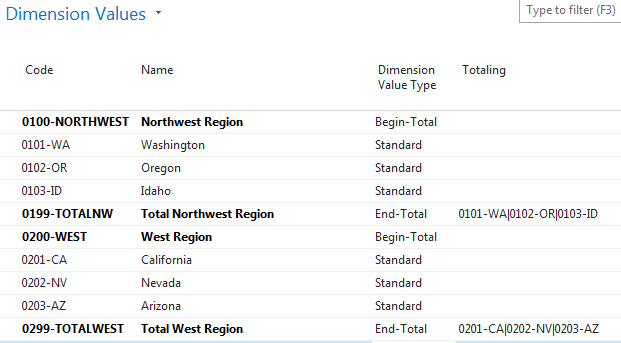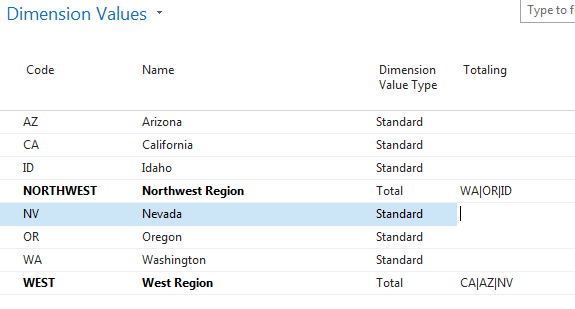Dimensions set up
-
Dimensions set up
Posted by Deb Peters on September 1, 2017 at 12:45 pm-
?We are very new to NAV. Barely into set up stages and working on defining our business product and customer reporting requirements. As we have been discussing the use of Dimensions for customers, this question has come up:
Is there a way to link Dimensions? If you have a Dimension for Industry and then another for Sector, which is a deeper dive from Industry, is there a way you can set them up so a user creating a new customer card only sees the Sector Dimension appropriate with the Industry Dimension entered. Kind of like a drop down. Maybe it’s a customization…
I understand Dimensions more like tags or identifiers that are not really linked but want to be sure I am thorough in my research. I was thinking it’s more of a training issue to define for our users what to choose. We are trying to “error proof” the entry of a new customer.
Thanks in advance for any advice to a new team.
Deb
——————————
Deb Peters, Controller
Midwest Rubber Service & Supply Co
Plymouth MN
—————————— -

Jeffery Rosenberger
MemberSeptember 1, 2017 at 1:54 PM
Hey Deb!
Welcome to the forums! Which Nav year are you using? With dimensions you can set them up and define which accounts are needing to use those dimensions. You can nest dimensions and have dimensions roll up to other dimensions or keep the dimensions separate.
In the case with your customers, you can do exactly as you’re wanting to do with standard Nav functionality.
Hope that helps!
——————————
Jeffery Rosenberger
Business Systems Analyst
Citizens Parking
Atlanta GA
——————————
——————————————- -

Caroline Brichford
MemberSeptember 4, 2017 at 6:10 AM
You can ‘link’ dimensions in Nav by using dimensions and setting up the required codes. We have division and branch set up, where division is a higher level that splits the business into two separate product types, beneath that we have set up a branch code which further delineates the location of each divisions activities.You can specify your item card masters by division for proper reporting. All sales reporting and departmental reporting are entered with these fields. Depending on how your company is run you may be able to specify by user what their standard transaction dimensions are if they work in only one. If cross dimensional the employees will need to remember.
Our set up works fairly well most of the time the biggest issue we run into is when purchasing fails to enter the proper division on a purchase of inventory then we are chasing down inventory postings with reclass entries.
Thank you,
Caroline Brichford
Vice President / Controller
Furukawa Rock Drill USASent from my iPhone
Disclaimer: The information is intended for the person or entity to which it is addressed and may contain confidential and/or privileged material.
Any review, retransmission, dissemination or other use of, or taking any action in reliance upon, this information by persons or entities other than the intended recipient is prohibited. If you received this in error, please contact the sender and destroy any copies of this document and any attachments.
——Original Message——
Hey Deb!
Welcome to the forums! Which Nav year are you using? With dimensions you can set them up and define which accounts are needing to use those dimensions. You can nest dimensions and have dimensions roll up to other dimensions or keep the dimensions separate.
In the case with your customers, you can do exactly as you’re wanting to do with standard Nav functionality.
Hope that helps!
——————————
Jeffery Rosenberger
Business Systems Analyst
Citizens Parking
Atlanta GA
—————————— -
Short of a customization, there are two ways of dealing with this out of the box. First off, the hierarchy you’re needing is not really available with dimensions.
One way of doing this is with dimension combinations. With combinations, you can specify which values from one dimension can be used with other dimension values. Unfortunately, users will still be able to see and select wrong dimension values which won’t become apparent until they try and post. Then the system will look at the combination and stop the posting of the combination is not valid.
The second approach is to use totaling within one dimension. For example, you might want to have one dimension for region and another dimension for state. You could use one dimension with Begin and End Totals to group the states. The issue with this approach is that NAV is going to sort the values which forces you to add something like numbers at the beginning to help with the sorting. This will allow report on both the states and the regions.

——————————
Dave Wiser
Controller
Beckwith & Kuffel
Seattle WA
——————————
——————————————- -
?We use the second approach that Dave Wiser suggested for 2 different dimensions in our data. It works very well for us.
——————————
Kari Strandberg
Bernatello’s Pizza, Inc
Maple Lake MN
——————————
——————————————- -
Just to add on to my previous post, if you’re not too concerned with the order of the dimensions in the Dimension Values page, you can leave off the sorting number at the beginning and use the “Total” dimension value type instead to group the values. NAV will sort the total lines with the others, but you will still be able to report based on the total. Depending on the reporting package you’re using, this approach also makes it easy to change regions. Using the example below, if you wanted to move Oregon to the West region, you would only need to add “OR” to the totaling for West the remove it from Northwest. This approach also allows you to have multiple Totaling regions that could contact the same state which can be used for different groupings.

——————————
Dave Wiser
Controller
Beckwith & Kuffel
Seattle WA
——————————
——————————————-
Deb Peters replied 8 years ago 1 Member · 0 Replies -
-
0 Replies
Sorry, there were no replies found.
The discussion ‘Dimensions set up’ is closed to new replies.


